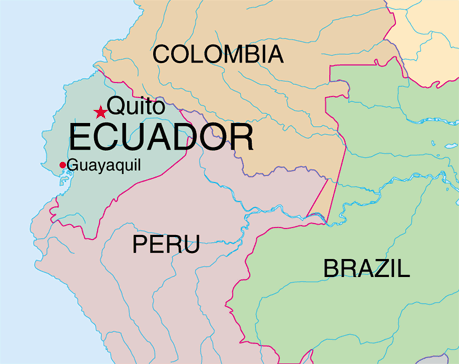Years
ago, I met a couple who said they were getting ready for a trip to Machu Picchu
as part of their backpacking tour of South America. I think I had barely heard
of it and was really not quite sure of which country it was in. They made it
sound impressive. Of course, not wanting to risk looking stupid, I asked an
open-ended question about their travel itinerary and pieced it all together. (I
Googled it later.) One of the most iconic places in South America, this ancient
Incan city is now a World Heritage Site.
The
name Peru is most likely stemmed from Birú; however, who Birú was referring to
is somewhat disputed in history. Some believe he was a local ruler who ruled
from what is now Panama, but other theories implied that he was a just an
Indian crewmember on a ship that belonged to the governor Pedro Arias de Ávila.
Regardless of its origin, it eventually changed over to Peru.
Peru
is located in the northeastern corner of South America. It borders Ecuador and
Colombia to the north, Brazil and Bolivia to the east, and Chile to the south.
It also has a long coastline along the Pacific Ocean to the west. The Andes
Mountains run down the coastline, dividing the country between the mountainous
region and a highlands region. The Amazon rainforest extends itself into Peru
as well, and many of the rivers that vein their way through the country are
actually extensions of the Amazon River. Because of this immense change in
scenery and altitude across the country (along with being near two major ocean
currents), Peru has quite a wide biodiversity.
The
earliest people in this area were of an agricultural-based society. During the
15th century, the Incan Civilization gained prominence in the Andes,
growing to be the largest civilization in the Americas during the pre-Columbian
era. With their capital in Cusco, their empire spread pretty much for the
entire western seaboard of South America. However, they were no match to the
Spanish Conquistadors. They pretty much exploited the people in their search
for gold and silver and anything else they thought could turn a quick buck. And
the Spanish brought quite a bit to the area: African slaves for labor,
diseases, Catholicism, and the Inquisition. It was like a hellish Christmas. By
the 18th century, several rebellions and reforms have taken place,
but most were suppressed. Much of Central and South America was swept up in the
mass independence movements during the early part of the 19th
century. Peru was able to gain theirs through the help of Simón Bolívar and
José de San Martín and their military power. As a new country, they worked to
expand the railroad system and a number of other infrastructure improvements
that ended up nearly bankrupting the country. There were a number of conflicts
between Peru and its neighbors throughout the latter part of the 19th
century and 20th century, several of which ended in many deaths on
both sides. Today, the country is working toward a better human rights record, peaceful
elections, and more transparency in government. (Most of the rest of us can
strive for this, too.)
The
capital city of Lima is not only the largest city in Peru, but it’s also one of
the largest metropolitan centers in South America. It was named after a famous
oracle (Limaq) who lived in the area.
The capital city is located along the Pacific coastline about halfway between
the borders. Lima (and not the Spanish word for lime, mind you) houses the center
of the federal government as well as being a center for commerce, finance, and
education. The National University of San Marcos is the oldest continuously
functioning university in Latin America, opening its doors in 1551. It’s a
global city, holding numerous international competitions, conventions, and
events.
Peru’s
economy is one of the fastest growing ones in the world. The World Bank
classified them as an upper middle income, and they also have a high Human
Development Index to match. Inflation is generally low, and unemployment rates
are falling. Agrarian reformation and income redistribution has helped with
some of this. Services account for more than half of the GDP, followed by
manufacturing. Trade has increased through free trade agreements, especially
with the US.
Roughly
97% of Peruvians are Christian, with about 80% of them being Catholic. The
remaining 3% are non-religious. However, there are also a number of indigenous
spiritual traditions that people also adhere to even if they are Christian, and
sometimes they merge the traditions of the two. Some of the Incan festivals,
such as Inti Raymi, are still celebrated to this day.
Peru
lists three official languages: Spanish, Quechua, and Aymara. In areas where
other indigenous languages take prevalence, those languages will also have a
quasi-official status for that area. Spanish is used as the language of the
government and in education and is spoken mostly among the coastal regions. In
the mountainous regions and other areas, Quechua and Aymara tend to be spoken
more than Spanish, especially in the Amerindian communities.
Lima
has made great strides in recent years at really creating a name for itself as
one of the global leaders in the culinary scene. Rivaling much larger cities,
Lima has several restaurants that have made the list of Top Restaurants in the
World. One of the key elements that many of Lima’s restaurants encompass is to
embrace its multiculturalism: its demographics include Incan and other
indigenous/pre-Columbian cultures, Spanish, Chinese, Japanese, Italian,
Lebanese, and several other immigrant cultures. And not only do they embrace
it, they blend it and merge it and create something that is quintessentially
Peruvian. I’m really excited to venture into this and find out more.
Up
next: art and literature












